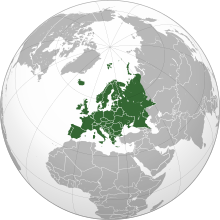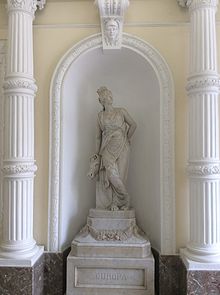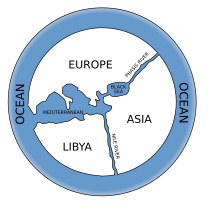ဥရောပ
 | |
| ဨရိယာ | 10,180,000 km2 (3,930,000 sq mi)[၁] (6th)[a] |
|---|---|
| လၟိဟ်မၞိဟ် | 746,419,440 (2018; 3rd)[၂][၃] |
| ဂတီု လၟိဟ်မၞိဟ် | 72.9/km2 (188/sq mi) (2nd) |
| GDP (nominal) | $21.79 trillion (2019; 3rd)[၄] |
| GDP (PPP) | $29.01 trillion (2019; 2nd)[၅] |
| Demonym | European |
| ဍုင်ဂမၠိုင် |
50 sovereign states 6 with limited recognition |
| ဒေသ မဗဒဗဒါဲဂမၠိုင် | 6 dependencies |
| အရေဝ်ဘာသာဂမၠိုင် | Most common first languages: |
| အခိင် | UTC−1 to UTC+5 |
| ဍုင်ဇၞော်ဂမၠိုင် | Largest urban areas: |


ဥရောပ (အၚ်္ဂလိက်: Europe) ဂှ် ဒှ်တိုက်မနွံ ပ္ဍဲကရေက်ဂၠးတိသၟဝ်ကျာ ကေုာံ ဗွဲမဂၠိုင် နွံကရေက်ဂၠတိ လပါ်ဗမံက်။ ယူရေသဳယျာ (Eurasia) လပါ်ပလိုတ် ဗွဲမဂၠိုင်ဂှ် ဒှ်တိုက်ဥရောပတုဲ ပိုင်ခြာလဝ် ပယျဵု ဗွဲဒိုဟ်သၟဝ်ကျာမ္ဂး မှာသၟိဒ်အန္တတိစ်၊ ဗွဲဒိုဟ်ပလိုတ်မ္ဂး မှာသၟိဒ်အန္တလာန်တိစ်၊ ဗွဲဒိုဟ်သမၠုင်ကျာမ္ဂး ၜဳလဒေါဝ်တၞဳ (Mediterranean Sea)တုဲ ဗွဲဒိုဟ်ဗမံက်မ္ဂး တိုက်အာရှ။ ဥရောပဂှ် ဗွဲမဂၠိုင် စၟတ်သမ္တီ ပါ်လဝ် ပယျဵု ကဵုအာရှ နကဵု ဒဵုဥရလ် (Ural Mountains) ကေုာံ ကြုင်ဥရလ် (Ural River)၊ ၜဳကာသပိန် (Caspian Sea)၊ ဂရံင်ဒဵု ကောစသုသ် (Greater Caucasus)၊ ၜဳဒမျိုင် (Black Sea) ကေုာံ ဇၟောဝ်ကြုင်တူရိကဳ (Turkish Straits)တအ်ရ။[၉] ဗွဲဓမ္မတာ ညးမဂွံပိုင်ခြာ တိုက်မွဲဂှ် ညးရံင်ကဵု ဒတန်တၞဟ်ခြာ ဟိုတ်နူကဵု မှာသၟိဒ်မဒၞာလဝ်ရ။ ပယျဵုဥရောပ ကဵု အာရှ ဂှ်ပါ်ကရေက်လဝ် ပ္ဍဲတိကီုလေဝ် ဟိုတ်နူ ဇမၞော်သမၠဲ၊ တၞောဝ်ဝင် ကေုာံ အခိုက်အလိုက်မၞိဟ်တုဲ ဥရောပဂှ် နဒဒှ် တိုက်တၞဟ်ခြာမွဲ စၟတ်သမ္တီလဝ်ရ။
တိုက်ဥရောပဂှ် နွံသမၠဲ ၜိုတ်10,180,000 km2 (3,930,000 sq mi)တုဲ ဂြောပ်ကေတ်လဝ်ဒၞာဲ လတူဂၠးတိဏအ် ၜိုတ် ၂% (၆.၈% ဨရဳယျာတိ)တုဲ မဒှ် တိုက်ဍောတ်အိုတ် မရနုက်ကဵု ၜါ။ နကဵု ပရေင်ဍုင်ကွာန်မ္ဂး ပ္ဍဲဥရောပဂှ် ပါ်လဝ် နကဵုဍုင် ၜိုတ် မသုန်စှ်ောဍုင်တုဲ ဍုင်ရုရှာဂှ် ဒှ်ဍုင်သမၠဲဇၞော်အိုတ်တုဲ လၟိဟ်မၞိဟ်လေဝ် ဂၠိုင်အိုတ်ကီုရ။ ဇမၞော်တိ ဥရောပ ၃၉% ဂှ် ဒှ်ဍုင်ရှရှာတုဲ လၟိဟ်မၞိဟ် ပ္ဍဲဥရောပ ၁၅% ဂှ် နွံပ္ဍဲရှရှာရ။ အိုတ်မွဲတိုက် ဥရောပဂှ် လၟိဟ်မၞိဟ်နွံ ၜိုတ် ၇၄၁ မဳလဳယာန် (ၜိုတ် ၁၁% လၟိဟ်မၞိဟ်ဂၠးတိ) as of 2018[update].[၂][၃] ရာသဳဥတု ဥရောပဂှ် တန်တဴဒၟံင် ကုဓါတ်ဂမ္တဴ နူကဵုၜဳအန္တာလာန်တိစ်တုဲ ပ္ဍဲတိုက်ဂှ် ဗွဲမဂၠိုင် မနွံကဵု ဥတုၜိုဟ်၊ ဥတုကညင်။ ဒေသမကြပ်ညောန် ကုၜဳတအ် ဥတုပြံင်လှာဲလောဲ နူကဵု ဒေသမသ္ၚောဲကဵုၜဳတအ်ရ။
ယေန်သၞာင် အခိုက်မၞိဟ်ဥရောပဂှ် ဒှ်ဂကောံမၞိဟ်ရးပလိုတ် မစေန်ဆက်ကၠုင် နူကဵုဂရိတ်တမၠာ ကေုာံ ရောမတမၠာ။[၁၀][၁၁]ကြဴနူ အေန်ပါယျာရောမ သရိုဟ် ပ္ဍဲ ၄၇၆ အေဒဳ ကေုာံ ကောန်မၞိဟ်တအ် ပြံင်မံင်ပဒတဴဒေသနာနာတုဲ ခေတ်တြေံဥရောပ စိုပ်ကၞောတ်အိုတ်တုဲ ဒှ်ကၠုင် ခေတ်လဒေါဝ် မဒှ်ခေတ် လညာတ်ဘာသာခရေတ်ယာန် မဓလီုလဝ်ရ။ နူဂှ် လညာတ်ကောန်မၞိဟ်ရေနာသာန်၊ ပါန်ကွတ်ရေနာသာန် ကေုာံ ကွတ်သိပ္ပံရေနာသာန် ကတဵုဒှ်တုဲ အရာဂှ် ဗဒှ်ကဵု ခေတ်တၟိဥရောပ။ စတမ်နူ ခေတ်ဂမၠာဲ (Age of Discovery) နကဵု ဂကူပဝ်တူဂြဳ ကေုာံ ဂကူသပိန်တအ် တိတ်တရဴ ဗက်ဂၠာဲဒၞာဲတၟိ၊ အရာတၟိတုဲ ဥရောပဂှ် ဒှ်ကၠုင်အရာအဓိက ပ္ဍဲကေင်ကာဂၠးတိ (ဝါ) ကောန်ဥရောပ ပကဵု ညံင်ဂၠးတိ ဂွံဆက်စၠောအ်ရေင်သကအ်ရ။ အကြာ ဗွဝ်ကၠံ ၁၆ ကဵု ၂၀ ဂှ် အဝဵုသြဇာ ဥရောပ မပကဝ်လဝ်နဳ ကုတိုက်တၞဟ် ဗီုကဵု တိုက်အမေရိက၊ တိုက်အာဖရိက ကြပ်သီုဖအိုတ် ကေုာံ တိုက်အဝ်သတြေလျ ကေုာံ တိုက်အာရှ ဒၞာဲဗွဲမဂၠိုင်တအ်ရ။
ခေတ်ပညာ (Age of Enlightenment)၊ နူဂှ် တဝ်စၞေဟ်ပြင်သေတ် (French Revolution) ကေုာံ ပၞာန်နပောလေယာန်ဂမၠိုင်တအ်ဂှ် ဗဒှ်ကဵု လညာတ်ပရေင်ဍုင်ကွာန်၊ ပရေင်ပိုန်ဒြပ် ကေုာံ အခိုက်မၞိဟ် ပ္ဍဲကဵုတိုက်ဂှ် ညံင်ဂွံပြံင်လှာဲ နူကၞောတ် ၁၇ ဗွဝ်ကၠံ စဵုကဵု တမ်လဒေါဝ် ၁၉ ဗွဝ်ကၠံရ။ တဝ်စၞေဟ်ကွတ်စက် (Industrial Revolution) ဂှ် စကတဵုဒှ် ပ္ဍဲဗြိတိန် ပ္ဍဲကၞောတ် ၁၈ ဗွဝ်ကၠံ၊ အရာဏအ်ဂှ် ပကဵု ပရေင်ပိုန်ဒြပ်၊ ပရေင်မၞိဟ် ဥရောပပလိုတ် ဂွံပြံင်လှာဲ ဂွံဇၞော်မောဝ်ရ။ ပၞာန်ဂၠးတိၜါအလန်ဂှ် စကတဵုဒှ် နူကဵု တိုက်ဥရောပ၊ ပၞာန်ဂၠးတိတအ်ဂှ် ဖန်ကဵု ညံင်ဂွံဖအောန်ဖျေဟ် ပရေင်ဥရောပပလိုတ် မအုပ်ဓလီုဂၠးတုဲ စတမ်နူ လဒေါဝ် ၂၀ ဗွဝ်ကၠံဂှ် ကၟိန်ဍုင်ပံင်ကောံသဵုဗိယေတ် ကဵု ကၟိန်ဍုင်ပံင်ကောံအမေရိက ဒှ်ကၠုင် မၞိဟ်အုပ်ဓလီုဂၠးတိရ။[၁၂] ပ္ဍဲအခိင်ကာလ ပၞာန်လၜိုဟ်ဂှ် ဥရောပ ပါ်အာၜါက္ဍိုပ် မကရေက်ဂှ် ဒှ်ဂကောံနေတဝ် မဒှ်ဂကောံပလိုတ်၊ မွဲဂကောံဂှ် ဂကောံလိက်ကသုက်ဝါသဝ် မဒှ်ဂကောံဗမံက်။ ဗီုဏအ် ကတဵုဒှ်လဝ် စဵုကဵု တဝ်စၞေဟ် ၁၉၈၉ ကေုာံ ကၟာင်ပါလေန်သရိုဟ်ရ။
ပ္ဍဲ သၞာံ ၁၉၄၉ ကံင်သဳဥရောပဂှ် ဒက်ပ္တန် နကဵုလညာတ်မ္ဂး သွက်ဂွံဒက်ပ္တန် ပရေင်သၟဟ်န်ဥရောပ ကေုာံ တၞဟ်နဂွံဝေင်ပါဲ ပၞာန်ဗွဲကြဴရ။ ပရေင်ပံင်ကောံဂှ် ဍုင်ပ္ဍဲဥရောပဗွဲမဂၠိုင် တုပ်စိုတ် ဒးဂၞပ်ကၠုင်တုဲ ဍုင်ဗွဲမဂၠိုင် ဒက်ပ္တန်ကၠုင် ဥရောပသမဂ္ဂ မကော်ဂး အဳယူ သွက်ဂွံဆက်ပံင်တောဲကၠောန် ကိစ္စ ပရေင်ဍုင်ကွာန်၊ ပရေင်ပိုန်ဒြပ် မဒှ်သၞောတ် မနွံအကြာ ကောန်ဖေဒေရေရှေန် (confederation) ကဵု သၞောတ်ဖေဒေရရှေန် (federation)ရ။[၁၃] ဥရောပသမဂ္ဂဂှ် နူတမ်မူလ ဒက်ပ္တန်လဝ် ပ္ဍဲကဵု ဥရောပပလိုတ်၊ စတမ်နူ ကၟိန်ဍုင်ပံင်ကောံသဵုဗိယေတ် သရိုဟ် ပ္ဍဲသၞာံ ၁၉၉၁ ဂှ်တုဲ ဆက်သမၠဲပတိတ် လပါ်ဗမံက်ရ။ လှုဲ မစကာ ပ္ဍဲကဵု ဍုင်မလုပ်လဝ် ဥရောပသမဂ္ဂ ဗွဲမဂၠိုင်ဂှ် ဒှ်သြန်ယူရဝ်တုဲ သီုဒှ်သြန်လဒေါဝ် မစကာ ပ္ဍဲကဵု ဍုင်ဥရောပဂမၠိုင်ရ။ တုဲပၠန် ပ္ဍဲဥရောပဂှ် စပ်ကဵု ကိစ္စမၞိဟ်လုပ်တိတ်ဂှ် ပံင်တောဲကၠောန်မွဲစွံ နကဵု ဂကောံရှေန်ဂေန်တုဲ ပ္ဍဲဂကောံဂှ် ဍုင်ကောန်ဂကောံ အဳယူကီု သီုကဵု ဍုင်ဟွံလုပ်အဳယူဂှ် ပံင်တောဲလဝ် နွံရ။
ယၟု
[ပလေဝ်ဒါန် | ပလေဝ်ဒါန် တမ်ကၞက်]

In classical Greek mythology, Europa (ဂရိတြေံ: Εὐρώπη, Eurṓpē) was a Phoenician princess. One view is that her name derives from the ancient Greek elements εὐρύς (eurús), "wide, broad" and ὤψ (ōps, gen. ὠπός, ōpós) "eye, face, countenance", hence their composite Eurṓpē would mean "wide-gazing" or "broad of aspect".[၁၄][၁၅][၁၆] Broad has been an epithet of Earth herself in the reconstructed Proto-Indo-European religion and the poetry devoted to it.[၁၄] An alternative view is that of R.S.P. Beekes who has argued in favor of a Pre-Indo-European origin for the name, explaining that a derivation from ancient Greek eurus would yield a different toponym than Europa. Beekes has located toponyms related to that of Europa in the territory of ancient Greece and localities like that of Europos in ancient Macedonia.[၁၇]
There have been attempts to connect Eurṓpē to a Semitic term for "west", this being either Akkadian erebu meaning "to go down, set" (said of the sun) or Phoenician 'ereb "evening, west",[၁၈] which is at the origin of Arabic Maghreb and Hebrew ma'arav. Michael A. Barry finds the mention of the word Ereb on an Assyrian stele with the meaning of "night, [the country of] sunset", in opposition to Asu "[the country of] sunrise", i.e. Asia. The same naming motive according to "cartographic convention" appears in Greek Ἀνατολή (Anatolḗ "[sun] rise", "east", hence Anatolia).[၁၉] Martin Litchfield West stated that "phonologically, the match between Europa's name and any form of the Semitic word is very poor",[၂၀] while Beekes considers a connection to Semitic languages improbable.[၁၇] Next to these hypotheses there is also a Proto-Indo-European root *h1regʷos, meaning "darkness", which also produced Greek Erebus.[နွံပၟိက် ဗၟံက်ထ္ၜးတင်နိဿဲ]
Most major world languages use words derived from Eurṓpē or Europa to refer to the continent. Chinese, for example, uses the word Ōuzhōu (歐洲/欧洲), which is an abbreviation of the transliterated name Ōuluóbā zhōu (歐羅巴洲) (zhōu means "continent"); a similar Chinese-derived term Ōshū (欧州) is also sometimes used in Japanese such as in the Japanese name of the European Union, Ōshū Rengō (欧州連合), despite the katakana Yōroppa (ヨーロッパ) being more commonly used. In some Turkic languages, the originally Persian name Frangistan ("land of the Franks") is used casually in referring to much of Europe, besides official names such as Avrupa or Evropa.[၂၁]
References
[ပလေဝ်ဒါန် | ပလေဝ်ဒါန် တမ်ကၞက်]- ↑ Largest Countries In Europe 2020.
- ↑ ၂.၀ ၂.၁ "World Population prospects – Population division". United Nations Department of Economic and Social Affairs, Population Division.
- ↑ ၃.၀ ၃.၁ "Overall total population" – World Population Prospects: The 2019 Revision (xslx). United Nations Department of Economic and Social Affairs, Population Division.
- ↑ GDP Nominal, current prices. International Monetary Fund (2019). Retrieved on 6 March 2019။
- ↑ GDP PPP, current prices. International Monetary Fund (2019).
- ↑ Demographia World Urban Areas. Demographia.
- ↑ The European flag, Council of Europe. Retrieved 27 October 2016.
- ↑ The European flag, Council of Europe. Retrieved 27 October 2016.
- ↑ (1999) National Geographic Atlas of the World, 7th, Washington, DC: National Geographic. ISBN 978-0-7922-7528-2။ "Europe" (pp. 68–69); "Asia" (pp. 90–91): "A commonly accepted division between Asia and Europe ... is formed by the Ural Mountains, Ural River, Caspian Sea, Caucasus Mountains, and the Black Sea with its outlets, the Bosporus and Dardanelles."
- ↑ Lewis & Wigen 1997, p. 226
- ↑ Kim Covert (2011). Ancient Greece: Birthplace of Democracy. Capstone, 5. ISBN 978-1-4296-6831-6။ “Ancient Greece is often called the cradle of western civilization. ... Ideas from literature and science also have their roots in ancient Greece.”
- ↑ National Geographic, 534.
- ↑ The European union—a federation or a confederation?.
- ↑ ၁၄.၀ ၁၄.၁ (24 May 2007) Indo-European Poetry and Myth. OUP Oxford, 185. ISBN 978-0-19-928075-9။
- ↑ Charles FitzRoy (26 February 2015). The Rape of Europa: The Intriguing History of Titian's Masterpiece. Bloomsbury Publishing, 52–. ISBN 978-1-4081-9211-5။
- ↑ Michael C. Astour (1967). Hellenosemitica: An Ethnic and Cultural Study in West Semitic Impact on Mycenaean Greece. Brill Archive, 128. GGKEY:G19ZZ3TSL38။
- ↑ ၁၇.၀ ၁၇.၁ "Kadmos and Europa, and the Phoenicians" (2004). Kadmos 43 (1): 168–69. doi:.
- ↑ "Europe" in the Online Etymology Dictionary.
- ↑ Michael A. Barry: "L'Europe et son mythe : à la poursuite du couchant". In: Revue des deux Mondes (November/December 1999) p. 110. ISBN 978-2-7103-0937-6.
- ↑ M.L. West (1997). The east face of Helicon: west Asiatic elements in Greek poetry and myth. Oxford: Clarendon Press, 451. ISBN 978-0-19-815221-7။.
- ↑ Davidson, Roderic H. (1960). "Where is the Middle East?". Foreign Affairs 38 (4): 665–675. doi:.
- Pages using ISBN magic links
- Articles containing potentially dated statements from 2018
- Articles with invalid date parameter in template
- All articles containing potentially dated statements
- All articles with unsourced statements
- Articles with unsourced statements from May 2020
- မုက်လိက်အရေဝ်ဘာသာဂျပါန်ဂမၠိုၚ်
- ဝင်ပထဝဳ
